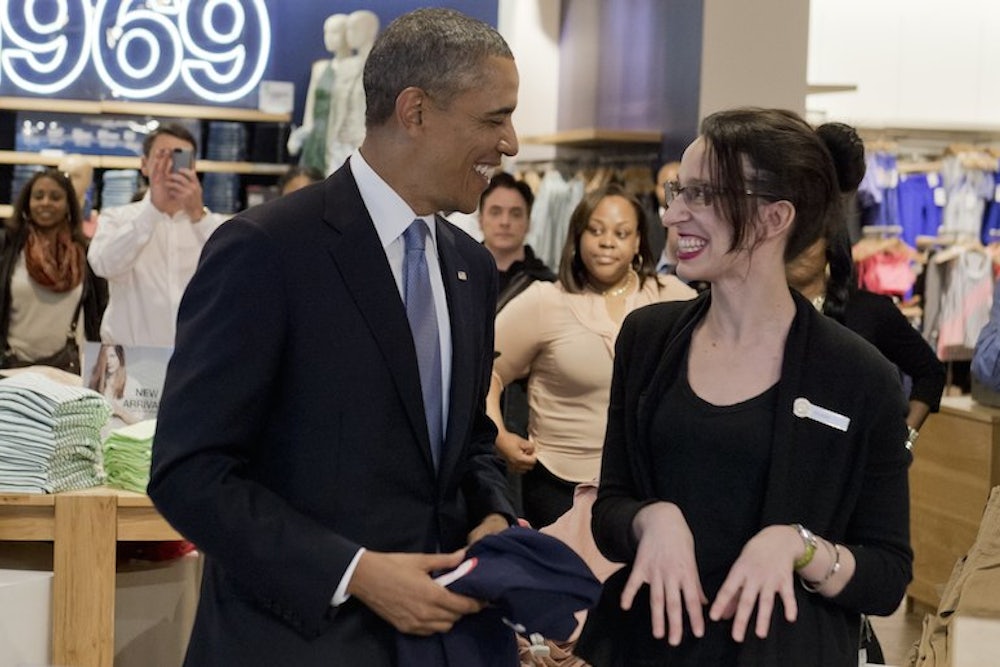President Obama on Tuesday is expected to sign two executive orders that will address the pay disparity between women and men. One will bar federal contractors from retaliating against employees who talk about their pay with each other. The other will require businesses to hand over data on pay, broken down by race and gender, to the Labor Department. The goal of both steps is to increase transparency, which is more important than it may sound. It’s hard to fight pay discrimination if you don’t even know what other people make.
That’s exactly what happened to Lilly Ledbetter, for whom the Lilly Ledbetter Act is named. She didn’t find out she was being paid less than the men around her until 19 years after she started at Goodyear. Even then, it was thanks only to an anonymous note. While President Obama has touted the fact that his first act as president was to sign that bill, it was a very, very incremental step toward gender wage parity. The law merely gives women more time to bring suits. The wage gap actually widened a bit afterward. Today, women who work full-time, year-round still make 77 percent of what similar men make, and progress has all but stalled for a decade.
The executive orders could start a new wave of progress. About half of American workers are either expressly barred or strongly discouraged from discussing pay with each other. Obama’s action won’t change that fact for everyone, but it will affect 22 percent of the workforce. And it can have ripple effects to other companies that might want to compete for federal contracts, changing standards over time.
There are already some climates where workers have much more leeway in talking about pay, and it’s no coincidence that the wage gap is smaller there. Among federal workers, just 18 percent of women and 11 percent of men say they are discouraged from talking pay. The wage gap between those workers shrank to 11 percent in 2007 from 28 percent in 1988. Unionized workers also tend to have more access to information on the pay of their coworkers, and again among those workers, the wage gap has been declining and is smaller than elsewhere—unionized women make more than 90 percent of what their male counterparts make, a 2.6 percent improvement from 2012.
Nobody should think that Obama’s actions Tuesday will fix the wage gap, full stop. The gap exists for many reasons, with discrimination likely among them. When the Government Accountability Office last looked at the issue, it couldn't explain 20 percent of the disparity between men's and women's pay, a gap that could be due to discrimination -- and that was after allowing for factors such as work patterns, occupation, job tenure, and race. Women make less than men the first year out of college even when accounting for a variety of factors such as grades, colleges, and majors, and they earn less than men at every educational level. They also learn less than men in nearly every job and every industry, including those that they have long dominated.
Conservatives like to emphasize the role that other factors, like choices about work-family balance, play in creating a pay gap. And it’s certainly true that women are more likely to interrupt their careers to care for children and other family members. More than 40 percent of women with children have reduced their hours at some point to care for someone, but just 28 percent of men have done so; similarly, 27 percent of mothers have had to quit their jobs, but just 10 percent of men had to leave. A little more than 10 percent of the gap is thanks to this dynamic, according to the Center for American Progress.
But that doesn’t mean the gap has to exist—or that government is powerless to address it. On the contrary, it’s an argument for programs that give parents more tools to balance work and family. In one study, mothers with regular care arrangements were twice as likely to stay in their jobs than those without, which helps them earn higher wages. Paid parental leave would help, by making it possible for both parents to take time off when a new child arrives without risking their pay or their job. It would also get men more involved with their children later on, changing the structure of who is the default caretaker. For mothers, those who get paid family leave are 50 percent more likely to see a boost in wages after they come back.
Some of these items are already on the Democratic agenda, although they don’t get that much attention. President Obama has proposed a universal preschool system that includes care for children ages zero to three and would go a long way toward helping parents afford the skyrocketing costs of child care. But many of these ideas are anathema to conservatives in Congress, because they would require government spending and/or interfering with the free market. Until that changes, executive orders like the ones Obama will issue Tuesday may be the best hope for a while.
Bryce Covert is Economic Policy Editor at ThinkProgress and a contributor at The Nation.
